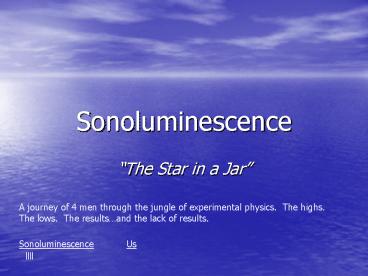Sonoluminescence - PowerPoint PPT Presentation
1 / 23
Title: Sonoluminescence
1
Sonoluminescence
- The Star in a Jar
A journey of 4 men through the jungle of
experimental physics. The highs. The lows. The
resultsand the lack of results.
Sonoluminescence
Us
llll
2
Adam Fox
Brendan Lyons
Dan Moulton
Jonathan Fulton
3
The Theory
- A loud, high frequency sound traps bubbles in the
resonance of a container - Bubbles expand and contract in a periodic manner,
and they give off short bursts of light
(1)
4
Why?
- An approximation of Navier-Stokes Equations gives
a good estimate of the motion of the bubble
(1)
- Why the light?
- Possible theories hotspot, collision induced
radiation, proton tunneling etc. - Reallythis is undecided.
5
Our initial setup
- Piezo-electric transducers drive a cylinder at
acoustical resonance - Over 700 V peak to peak is required across the
transducers - A microphone is attached to the cylinder to
measure what is going on inside the system. - An RLC circuit is used to resonate at the same
frequency as the resonant frequency of the flask.
6
Drive Transducer
Microphone
7
The circuit
Tuned Inductors
(2)
8
To attain electrical resonance
- A network of inductors was used.
- W0 1 / Sqrt(LC)
Coil of wire
9
To attain acoustical resonance
- The signal generator is used to sweep through
frequencies until the highest reading on the
microphone is attained - Acoustical resonance of the cylinder is about
11.5 khz, which is in the range of hearing.
(the wave equation)
10
The problems
- It is extremely difficult to fill the flask with
completely degassed water, which is essential to
achieve sonoluminescence - The resonant frequency was in our range of
hearing.
11
Solution
- We moved to a spherical flask.
(3)
Acoustical Resonance about 23.5 khz
12
More problems
- It is extremely difficult to tune to electrical
resonance - We had no ferrite rod, only steel.
- The fringe effects on the solenoid causes enough
inaccuracy. - So, we dont get nearly enough voltage across the
transducers.
13
More solutions
- A Yamaha Model A-550 was found and used to
further amplify the signal - This acts as a tunable transformer. Combining
this with the 15, we were able to get the
required 700 Vp-p across the transducers!
14
(No Transcript)
15
(Picture stolen from http//www.techmind.org/sl/,
then modified)
33mH Inductor
Stereo Amp
Audio Amp
V
Signal Generator
(2)
16
Preparation of the water
Deionize
Degas
Also, the water should be quite cool (0-10
degrees C)
17
After a few attempts
Our best trial run gave
- Resonant frequency of the flask (measured)
23.406 khz - Voltage across transducers 707 V
- Microphone signal (measured w/oscilloscope) 3.58
Vp-p
18
To insert a bubble
- A small syringe is used to remove some liquid,
and then inject one or two small bubbles on the
surface
19
Ideally...
- If the flask is being driven at acoustical
resonance, small bubbles will move from the
surface to the center of the flask - The bubble at the center will give us
sonoluminescence.
20
What happened to us
- No bubbles were observed to move to the center,
although the oscilloscope reading suggested that
there were bubbles injected into the liquid - Small distortions on scope
21
Perhaps?
- It is possible that we actually were able to
successfully create this sonoluminesence, but we
werent able to observe either the bubble or the
light. - Our method of injecting bubbles was flawed, and
it disturbed the system too much (bubbles
sticking to walls, etc).
22
- Thanks to Lyman and Wei for providing much-needed
help, teaching us how to use the electrical
equipment, etc. - This course taught us that experimental physics
is extremely hardbut it provides the best
opportunity for active learning.
23
Bibliography
- http//en.wikipedia.org/wiki/Sonoluminescence
- http//www.techmind.org/sl/
- http//sps.nus.edu.sg/pokailin/acad/72.pdf































